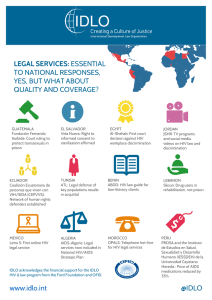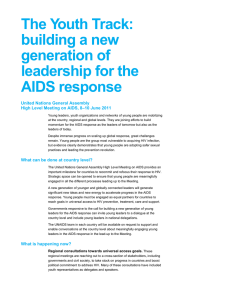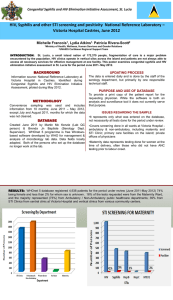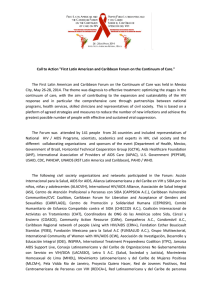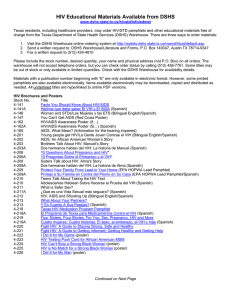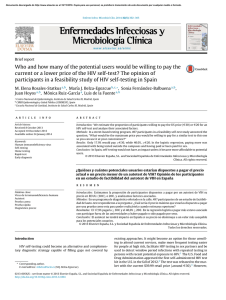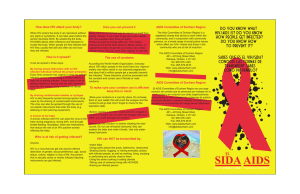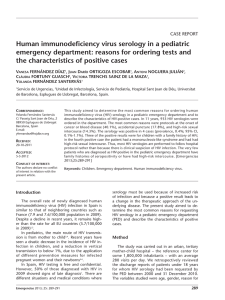Consumption of injecting heroin in Colombia and risk
Anuncio
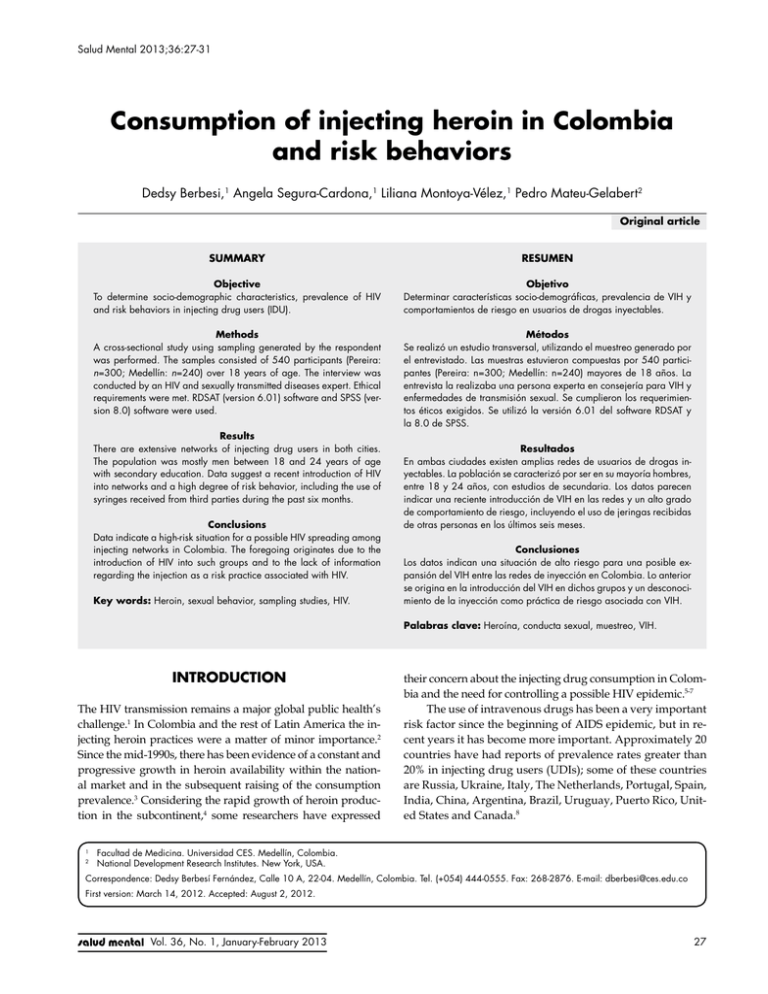
Salud Mental 2013;36:27-31 Consumption of injecting heroin in Colombia and risk behaviors Consumption of injecting heroin in Colombia and risk behaviors Dedsy Berbesi,1 Angela Segura-Cardona,1 Liliana Montoya-Vélez,1 Pedro Mateu-Gelabert2 Original article SUMMARY RESUMEN Objective To determine socio-demographic characteristics, prevalence of HIV and risk behaviors in injecting drug users (IDU). Objetivo Determinar características socio-demográficas, prevalencia de VIH y comportamientos de riesgo en usuarios de drogas inyectables. Methods A cross-sectional study using sampling generated by the respondent was performed. The samples consisted of 540 participants (Pereira: n=300; Medellín: n=240) over 18 years of age. The interview was conducted by an HIV and sexually transmitted diseases expert. Ethical requirements were met. RDSAT (version 6.01) software and SPSS (version 8.0) software were used. Métodos Se realizó un estudio transversal, utilizando el muestreo generado por el entrevistado. Las muestras estuvieron compuestas por 540 participantes (Pereira: n=300; Medellín: n=240) mayores de 18 años. La entrevista la realizaba una persona experta en consejería para VIH y enfermedades de transmisión sexual. Se cumplieron los requerimientos éticos exigidos. Se utilizó la versión 6.01 del software RDSAT y la 8.0 de SPSS. Results There are extensive networks of injecting drug users in both cities. The population was mostly men between 18 and 24 years of age with secondary education. Data suggest a recent introduction of HIV into networks and a high degree of risk behavior, including the use of syringes received from third parties during the past six months. Conclusions Data indicate a high-risk situation for a possible HIV spreading among injecting networks in Colombia. The foregoing originates due to the introduction of HIV into such groups and to the lack of information regarding the injection as a risk practice associated with HIV. Key words: Heroin, sexual behavior, sampling studies, HIV. Resultados En ambas ciudades existen amplias redes de usuarios de drogas inyectables. La población se caracterizó por ser en su mayoría hombres, entre 18 y 24 años, con estudios de secundaria. Los datos parecen indicar una reciente introducción de VIH en las redes y un alto grado de comportamiento de riesgo, incluyendo el uso de jeringas recibidas de otras personas en los últimos seis meses. Conclusiones Los datos indican una situación de alto riesgo para una posible expansión del VIH entre las redes de inyección en Colombia. Lo anterior se origina en la introducción del VIH en dichos grupos y un desconocimiento de la inyección como práctica de riesgo asociada con VIH. Palabras clave: Heroína, conducta sexual, muestreo, VIH. INTRODUCTION The HIV transmission remains a major global public health’s challenge.1 In Colombia and the rest of Latin America the injecting heroin practices were a matter of minor importance.2 Since the mid-1990s, there has been evidence of a constant and progressive growth in heroin availability within the national market and in the subsequent raising of the consumption prevalence.3 Considering the rapid growth of heroin production in the subcontinent,4 some researchers have expressed 1 2 their concern about the injecting drug consumption in Colombia and the need for controlling a possible HIV epidemic.5-7 The use of intravenous drugs has been a very important risk factor since the beginning of AIDS epidemic, but in recent years it has become more important. Approximately 20 countries have had reports of prevalence rates greater than 20% in injecting drug users (UDIs); some of these countries are Russia, Ukraine, Italy, The Netherlands, Portugal, Spain, India, China, Argentina, Brazil, Uruguay, Puerto Rico, United States and Canada.8 Facultad de Medicina. Universidad CES. Medellín, Colombia. National Development Research Institutes. New York, USA. Correspondence: Dedsy Berbesí Fernández, Calle 10 A, 22-04. Medellín, Colombia. Tel. (+054) 444-0555. Fax: 268-2876. E-mail: [email protected] First version: March 14, 2012. Accepted: August 2, 2012. Vol. 36, No. 1, January-February 2013 27 Berbesi et al. The HIV epidemic among UDIs sets itself apart from other populations because it may be rapidly spread within this community and then to the general population.9 As for UDIs, the main risk factor that increases the possibility of transmission is the sharing of syringes and needles, mainly among young people, where infection reports amount to 43.5%.10 While the most affected persons are men, some studies report that 31% of women confessed that they were injected with previously used needles,11 which also includes them in the risk group. Furthermore, women who are UDI sexual partners are more likely to be exposed as receivers after the injection of his/her sexual partner. This is particularly common in developing countries.12 Due to their sexual practices, UDIs are at a greater risk of acquiring sexually transmitted diseases, especially HIV. Also, women have a greater tendency to be engaged in risky sexual behaviors such as exchanging sex for money or drugs, having multiple sexual partners, sharing needles during intercourse or having unprotected sex with an UDI partner.13 Among the socio-cultural factors that have influence on the greatest risk for VIH acquisition14 are low decisionmaking capacity, lack of education access, family and social problems generating psychotic behaviors that worsen with unemployment and serious economic difficulties that lead the person to live under a social iniquity status, which may cause a greater HIV transmission in this population.15 Two cities were chosen to determine the injecting drug consumption in Colombia: Medellín and Pereira, located in the cultivation areas of poppy (Coffee-Growers Axis/ Eje Cafetero). Through the Respondent-Driven Sampling16 (RDS),17,18 HIV risk and prevalence practices were assessed among the injecting drug users of both cities. The Respondent-Driven Sampling has emerged as an alternative for hidden populations.19,20 The objective of this research was the identification of risk behaviors for HIV transmission on injecting drug users from two Colombian cities: Medellín-Antioquia and Pereira-Risaralda. MATERIALS AND METHODS Information gathering was made during the second semester of 2010 in Medellín and Pereira. Samples consisted of a total of 540 participants (Pereira: n=300; Medellín: n=240) over 18 years of age. These cities were selected due to two main reasons: firstly, both had previous studies21,22 reporting about an important number of injecting drug users; secondly, such cities have been micro-trafficking epicenters.23 The two cities produced a diverse sample of injecting drug users from Colombia as well as a comparison of two different epidemiological trends at an urban area. Due to the type of study population, it was not possible 28 to have a known sampling frame allowing the design of a conventional probability sample. Thus, the solution was a chain referral sampling based on respondents, a method that has been found useful to access hard-to-reach populations, such as injecting drug users, which consists of a chain referral sampling, but incorporating social network theories to obtain a sampling that approximates the study population. Recruitment starts with a group of “seeds” or non-randomized participants of the target population. For this research an initial amount of three seeds was determined from the possible seeds for each city. From these seeds the recruitment chains started, hence achieving a regional sampling of minimum 200 participants. These persons received two types of incentives: a primary incentive or for participating in the study; and a secondary incentive, related to the successful recruitment of three new participants (ranging between approximately USD$4 or USD$5 dollars, respectively). The selection of seeds was based on four sociodemographic variables that could establish networks and subgroups within UDIs. 20 potential seeds were identified (Pereira: n=12; Medellín: n=8), which changed according to the socio-economic background, gender, educational level (primary, high school and college) and age. The seeds were recruited through key informants. To start the second stage, an explanation of the recruitment process was given to the interviewed seeds, including inclusion criteria like being 18 years of age or older and an injecting drug consumer in each city. Their fellows, in turn, recruited other persons for the study. The target sample size was reached on an eight-week term. An HIV and sexually transmitted diseases expert conducted the interview, which averaged 60 minutes long. The instrument included questions about demographic features, HIV knowledge and an HIV test. Approved ethical requirements were met. RDSAT (version 6.01) software was used to estimate the prevalence of variables of interest. RESULTS Configuration of networks Three networks were achieved in each city from three seeds, as shown in Figure 1. Medellín Pereira Figure 1. Social networks in Medellín and Pereira. HIV prevalence in injecting drug users. 2011 Vol. 36, No. 1, January-February 2013 Consumption of injecting heroin in Colombia and risk behaviors Demographic characteristics UDI’s population resulted in: men (92.8%), single (81.3%), under the age of 30 (85.7%), with secondary education (89.5%). Age range: 18-58 years old (25 ± 6.3). 76.7% belonged to a low socioeconomic status; 20% middle status; and 3% high status. 44% of UDIs have used —during the last six months— third-party syringes. Generally, they clean such items with water (67%), then alcohol (8.5%) or boiling water (2.4%). No gender differences were found when analyzing the habit of sharing syringes, but there were differences regarding living by oneself, consuming basuco (which may diminish the effects of heroin) or ecstasy (Tables 1 and 2). Use of drugs and alcohol HIV prevalence Most of the study participants were recent drug consumers, with an average time of 4 (±3) years. Drugs currently used included basuco (40.7%), marihuana (88%) and cocaine (60%). Alcohol abuse was reported by 67%. All were injecting heroin users. The estimated HIV prevalence for the UDI’s population was 2.0% [IC 95%: 0.7%-3.3%]; for men 1.99% [IC 95%: 0.67%-3.3%] and for women 2.56% [IC 95%: 0.06%-13.4%], with no statistically significant differences by gender. Sexual behavior DISCUSSioN The current number of sexual partners ranged among groups. More than half the participants (54%) confirmed having intercourse with occasional partners during the last six months, 27% reported having between 2 and 10 occasional sexual partners and 4% having more than 10 sexual partners during the last six months. Fifty two per cent affirmed having intercourse with casual partners and 15% with clients; 65% of participants had intercourse with a permanent sexual partner. Ten per cent reported intercourse with multiple partners either in exchange for drugs and/or money, being four times more probable for women to exchange sex for drugs and/or money than men (OR=4.71; IC 95% 2.2-10.7, p=0.00). Consistent condom use was indicated only by 16% of participants and 14% of men used during vaginal intercourse. Those who had more partners confessed a similar condom use during vaginal intercourse (16%) and 33% of the study population affirmed that they had never used a condom. Users who share needles have twice the risk of using a condom (OR=2.10; IC 95% 1.2-3.5; p=0.00). 27% of UDIs who share needles have intercourse with other UDI users. It is estimated that 29% of the more than two million LatinAmerican injecting drug users is infected by HIV.24 This research identified HIV presence in injecting drug population of two Colombian cities and the existence of established parenteral heroin consumption with risk behaviors. Therefore, these are predisposing factors for a possible HIV spreading between UDIs and their sexual networks, as has been evidenced by other researches.25,26 Data of this report indicate a high-risk situation for a rapid HIV spreading among injecting networks due to the lack of information for effective measures to clean reused and/or shared equipments. If scientific knowledge and experience of the last decades is applied on epidemic prevention of injecting drug users, there would be a unique chance to prevent the rapid HIV spreading through UDI’s networks. UDI’s willingness to implement preventive measures referred by the respondents must be reinforced through programs providing information on effective practices for HIV prevention.27 It bears mention that most of them use water to clean the injecting equipment, which reveals a lack of information for effective disinfection measures. Table 1. Socio-demographic characteristics of the IDU’s Share syringes Yes No p Value Variable N % n Gender •Men •Women 213 21 91.0 9.0 288 18 94 1.89 0.111 0.63 6 Live with parents •No 139 •Yes 95 59.4 40.6 156 150 51 49 3.79 0.031 1.4 (0.9-1.9) Live alone •Yes •No 31.2 68.8 67 239 22 78 5.97 0.01 1.67 (1.0-2.3)* 73 161 % Chi square OR 95% CI (0.32-1.21) * p value < 0.05 and confidence interval with lower limit greater than 1. Vol. 36, No. 1, January-February 2013 29 Berbesi et al. Table 2. Consumption of other drugs in the IDU’s population Share syringes Yes Variable Basuco •Yes •No Inhalants •Yes •No Acids •Yes •No Ecstasy •Yes •No Cigarette •Yes •No Alcohol •Yes •No Total No Chi square p Value OR 95% CI 36 64 6.72 0.006 1.58 (1.11-2.23)* 49 257 16 84 3.81 0.033 1.53 (0.99-2.36) 68.8 31.2 163 143 53 47 13.34 0.000 1.93 (1.35-2.76)* 33 201 14.1 85.9 26 280 8 92 4.28 0.027 1.76 (1.02-3.04)* 217 17 92.7 7.3 270 36 88 12 3.03 0.0816 1.70 (0.93 -3.11) 167 67 71.4 28.6 194 112 63 37 3.8 0.031 1.43 (0.99-20.7) N % n % 110 124 47.0 53.0 110 196 53 181 22.6 77.4 161 73 234 306 * p value < 0,05 and confidence interval with lower limit greater than 1. UDIs trend of having more than one high-risk behavior, such as sex trade, boosts the likelihood of infection. Evidence indicates that sexual transmission both from injection and non-injection of drug consumers plays an important role in HIV spreading worldwide.28 Thus, drug consumers, in spite of their drug injecting behavior, are a bridging population making easier the spreading of blood-borne diseases beyond the drug consuming population.29 Heroin’s availability and accessibility in Colombia and its impact on the human immunodeficiency virus transmission by intercourse or injection needs the design of strategies aimed at controlling an impending epidemic. Therefore, the application of experiences and effective measures are required to diminish infection risks.30 It is important to increase the knowledge level about HIV risks and other infections (hepatitis C, bacterial infections) related to the injecting practices.31 In some countries strategies to diminish the transmission of this pathology are already being implemented; such as: opioid substitution therapy, syringe replacing counseling and programs, safe disposal of contaminated needles and syringes. It is quite important that governments keep investing in public health policies and in HIV prevention strategies for UDIs, as well as focusing on risk populations, since several Latin-American countries, including Colombia, have groups with this infection. REFERENCES 1. OMS, UNODC. Informe hacia el acceso universal; 2010. Available at http://www.who.int/hiv/universalaccess2010/es/index.html. Access date: June 17, 2011. 30 2. Organización Panamericana de la Salud. Oficina de Naciones Unidas. VIH y SIDA en las Américas España: 2001. 3. Mejía Motta I E. La inyección de drogas en Bogotá: Una realidad oculta. Bogotá, Colombia; Presidencia de la Republica de Colombia; 2003. 4. Naciones Unidas. Oficina contra la Droga y el Delito. Tendencias mundiales de las drogas ilícitas. Available at: http://www.portalfarma.com/pfarma/taxonomia/general/gp000012.nsf/voDocumentos/ 1A6BB7A9C264ABA4C1256F89005D0099/$File/43-49-Tendencias.pdf. Access date: June 17, 2011. 5. Mejia IE, Perez A. La inyección de drogas en Bogotá: una amenaza creciente. Adicciones 2005;17 (3):251-260. 6. Usuarios de drogas inyectables y acceso a tratamiento. Disponible en: http://www.icw.org/files/IDUES.pdf. Access date: January 24, 2011. 7. Zurmühl U, Lechner I. VIH/SIDA en Latinoamérica y el Caribe. FAKT. Alemania.2006. Available at: http://www.portalsida.org/repos/vihsida_ en_el_latinoamerica_y_el_caribe.pdf. Access date: June 17, 2011. 8. Aceijas C, Stimson GV, Hickman M, Rhodes T. Global overview of injecting drug use and HIV infection among injecting drug users. AIDS 2004;18(17):2295-2303. 9. The science of improving lives. Usuarios de drogas inyectables. Available at: http://www.fhi.org/sp/Topics/Injection+Drug+Users+topic+p age.htm. 10. Chu TX, Levy JA. Injection drug use and HIV/AIDS transmission in China. Cell Res 2005;15(11-12):865-869. 11. Reid SR. Injection drug use, unsafe medical injections, and HIV in Africa: a systematic review. Harm Reduct J 2009;6:24. 12. Ross MW, McCurdy SA, Kilonzo GP, Williams ML et al .Drug use careers and blood-borne pathogen risk behavior in male and female Tanzanian heroin injectors. Am J Trop Med Hyg 2008;79(3):338-343. 13. Kozlov AP, Shaboltas AV, Toussova OV, Verevochkin SV et al. HIV incidence and factors associated with HIV acquisition among injection drug users in St Petersburg, Russia. AIDS 2006;20(6):901-906. 14. Mathers BM, Degenhardt L, Ali H, Wiessing L e t al. HIV prevention, treatment, and care services for people who inject drugs: a systematic review of global, regional, and national coverage. Lancet 2010;375(9719):1014-1028. Vol. 36, No. 1, January-February 2013 Consumption of injecting heroin in Colombia and risk behaviors 15. Steffanie A, Strathdee TB. HIV and risk environment for injecting drug users: the past, present and future. Lancet 2010;376:268-284. 16. Medina-Mora ME. Estudio de poblaciones ocultas y de difícil acceso. Available at: http://www.conadic.salud.gob.mx/pdfs/publicaciones/ obs02met.pdf 17. Heckathorn DD. Respondent-driven sampling: a new approach to the study of hidden populations. Social Problems 1997; 44:174–199. 18. Heckathorn DD, Semaan S, Broadhead R, Hughes JJ. Extensions of respondent-driven sampling: A new approach to the study of injection drug users aged 18–25. AIDS Behavior 2002; 6:55-67. 19. UNAIDS. Guidelines on estimating the size of populations most at risk to HIV. Available at: http://www.unaids.org/en/media/unaids/ contentassets/restore/2011. Estimating_Populations_en.pdf. Access date: June 17, 2011. 20. ONUSIDA. Marco para la vigilancia y la evaluación de los programas de prevención del VIH dirigidos a las poblaciones de mayor riesgo. Suiza; 2008. 21. Isaza C, Suarez P, Henao J, Gonzalez M. Características demográficas y de consumo en pacientes adictos a heroína o derivados de la coca. Investigaciones Andina 2010; 12:24-34. 22. Castaño G, Calderón GA. Consumo de heroína en Colombia, prácticas relacionadas e incidencia en la salud pública. Revista Cubana Salud Pública 2010; 36(4):311-322. 23. Perez A. Micro tráfico de heroína, un tercer estudio realizado en Medellín y Bogotá en el 2009. Colombia: Ministerio de Protección Social; 2010. 24. ONUSIDA. Situación de la Epidemia de SIDA. Available at: http:// www.unaids.org/globalreport/Global_report_es-hts. Access date: June 17, 2011. 25. Metzger DS, Navaline H. Human immunodeficiency virus prevention and the potential of drug abuse treatment. Clinical Infectious Diseases 2003;5(37 Supl 5):S451-S456. 26. World Health Organization. Evidence for action: Effectiveness of drug dependence treatment in preventing HIV among injection drug users. Ginebra, Suiza: 2005. 27. Center for Disease Control and Prevention. Management of Possible Sexual, Injecting-Drug-Use, or Other Nonoccupational Exposure to HIV, Including Considerations Related to Antiretroviral Therapy Public Health Service Statement Morbidity and Mortality Weekly Report 1998 Sept 25;47(RR17):1-14. Available at: http://www.cdc.gov/mmwr/ preview/mmwrhtmil/00054952.htm. Access date: June 17, 2011. 28. Ross MW, Williams ML . Sexual behavior and illicit drug use. Annu Rev Sex Res 2001;12:290-310. 29. Shehane E, Jacobson JO, Iguchi MY. Un estudio para identificar comportamientos de riesgo y necesidades de prevención de VIH/SIDA en Centros de Tratamiento de Drogadicción en la Ciudad de Guatemala y San Salvador. Guatemala, 2008. Available at: http://www.seguridad.gob.sv/ observatorio/demanda/2008/VIH:UDI_Esp_Final.pdf. Access date: June 17, 2011. 30. Hacker MA, Malta M, Enriquez M, Bastos F. Human immunodeficiency virus, AIDS, and drug consumption in South America and the Caribbean: epidemiological evidence and initiatives to curb the epidemic. Rev Panam Salud Publica 2005;18(4-5):303-13. 31. Rodríguez CM, Marques LF, Touzé G. HIV and injection drug use in Latin America. AIDS 2002;16 (Supl 3):S34-S41. Declaration of conflict of interests: None Vol. 36, No. 1, January-February 2013 31
